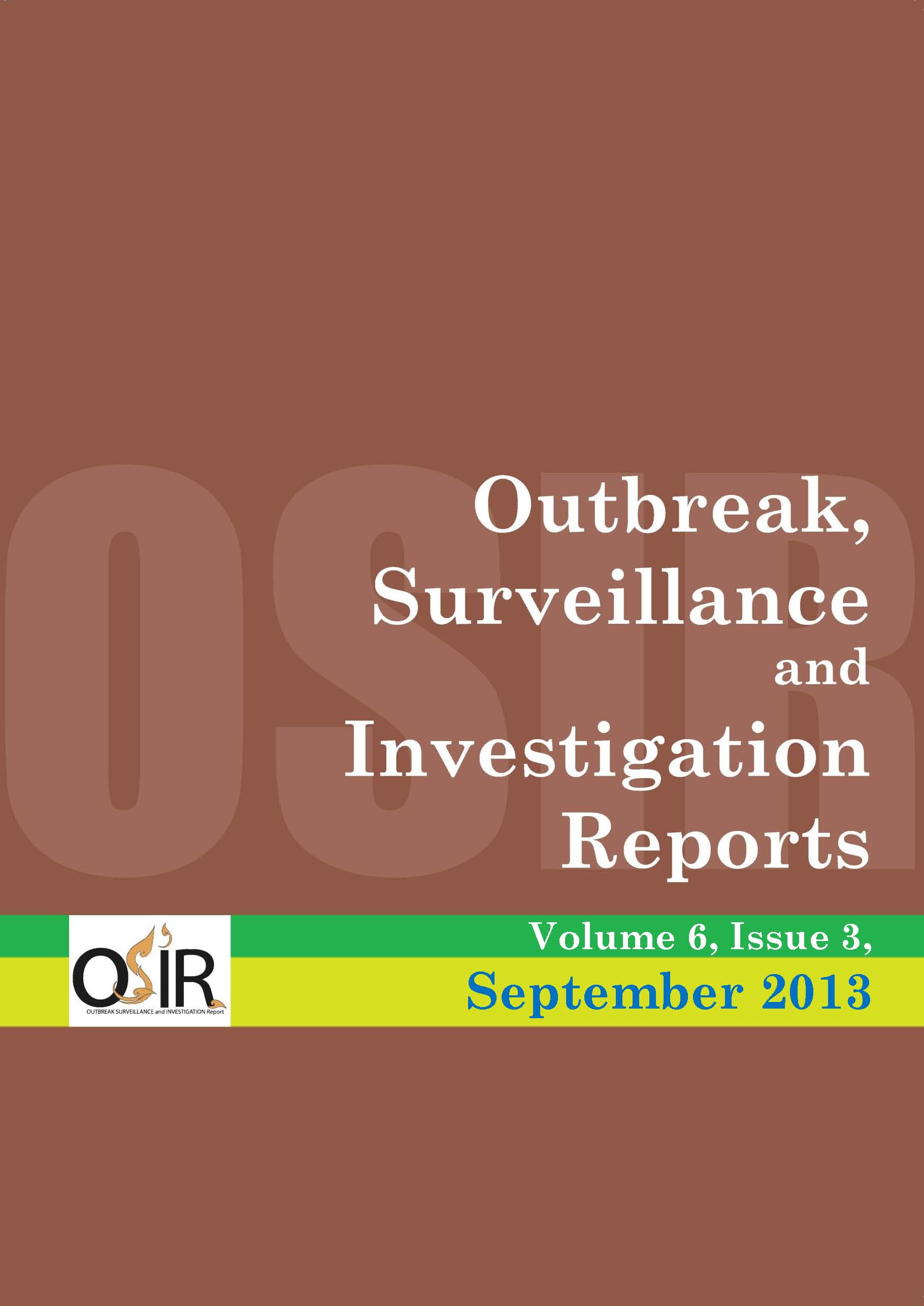Viral Shedding in University Students Infected by Influenza A(H1N1)pdm09, Nakhon Ratchasima Province, Thailand, June 2011
DOI:
https://doi.org/10.59096/osir.v6i3.263326Keywords:
influenza A(H1N1)pdm09, viral shedding, outbreak, university, ThailandAbstract
Oseltamivir is often prescribed to treat influenza patients, yet its effect on viral shedding among Thai young adults infected with influenza A(H1N1)pdm09 virus remained unclear. During May to June 2011, an influenza A(H1N1)pdm09 outbreak was detected in University S, Nakhon Ratchasima Province, Thailand. A prospective observational study was conducted to define duration of viral shedding and immunologic response in infected students undergoing oseltamivir treatment, and identify factors associated with viral shedding. We enrolled all acute respiratory illness (ARI) patients attending the medical center at University S during 3-7 Jun 2011 with laboratory confirmation of influenza A(H1N1)pdm09 infection by real-time reverse transcription polymerase chain reaction (rRT-PCR). Additional throat swabs were collected and tested daily until rRT-PCR results became negative through two consecutive days. Series of serum samples for hemagglutination inhibition (HI) test were also collected from the individuals. Log-rank test was applied in analysis of association between patients’ characteristics and duration of viral shedding. Of 29 sick students enrolled, 45% were males. All were prescribed oseltamivir for five days and none of them were hospitalized. Median duration from onset of symptoms to the last day of viral shedding detected was five days (range 3-9 days). Over 80% of the patients had 4-fold rises of HI titer within 2-3 weeks after onset of symptoms. None of the patients’ characteristics were significantly associated with duration of viral shedding. However, persons with delayed antiviral treatment tended to have longer duration of viral shedding. Early oseltamivir treatment probably reduced risks of severe influenza in young adult patients. However, guidelines on infection control need to emphasize on strict hygiene and prevention measures in treated patients for nine days in order to minimize the risks of influenza transmission.
References
Ling LM, Chow AL, Lye DC, Tan AS, Krishnan P, Cui L, et al. Effects of early oseltamivir therapy on viral shedding in 2009 pandemic influenza A (H1N1) virus infection. Clin Infect Dis. 2010 Apr;50(7):963-9.
Yu H, Liao Q, Yuan Y, Zhou L, Xiang N, Huai Y, et al. Effectiveness of oseltamivir on disease progression and viral RNA shedding in patients with mild pandemic 2009 influenza A H1N1: opportunistic retrospective study of medical charts in China. BMJ. 2010;341:c4779.
Jia N, Gao Y, Suo JJ, Xie LJ, Yan ZQ, Xing YB, et al. Viral shedding in Chinese young adults with mild 2009 H1N1 influenza. Chin Med J (Engl). 2011;124(10):1576-9.
Suryaprasad A, Morgan OW, Peebles P, Warner A, Kerin TK, Esona MD, et al. Virus detection and duration of illness among patients with 2009 pandemic influenza A (H1N1) virus infection in Texas. Clin Infect Dis. 2011 Jan 1;52 Suppl 1:S109-15.
Vatthanasak A, Pittayawonganon C, Kongyu S, Iamsirithaworn S. Infection rate, duration of viral shedding and viral load in an outbreak of novel influenza A (H1N1) 2009 infections among military conscripts in a training center, Thailand, June 2009. Weekly Epidemiological Surveillance Report. 2010;41(14):209-13.
Kuttiyawithayakoon V, Mungaomklang A, Kaewmalung P, Silanan K, silaporn P, Iamsirithaworn S. Viral loads and duration of viral shedding of influenza A (H1N1) 2009 among patients receiving oseltamivir during the institutional outbreaks, Nakhon Ratchasima Province, 2009. Journal of Health Science. 2011;20(SI):95-103. Thai.
To KK, Chan KH, Li IW, Tsang TY, Tse H, Chan JF, et al. Viral load in patients infected with pandemic H1N1 2009 influenza A virus. J Med Virol. 2010 Jan;82(1):1-7.
Cao B, Li XW, Mao Y, Wang J, Lu HZ, Chen YS, et al. Clinical features of the initial cases of 2009 pandemic influenza A (H1N1) virus infection in China. N Engl J Med. 2009;361(26):2507-17.
Chen Y, Qiao H, Zhang CM, Tong M, Shang S. Risk factors for prolonged shedding of 2009 H1N1 influenza virus. Indian Pediatr. 2011 Dec;48(12):961-3. Epub 2011 May 30.
Li IW, Hung IF, To KK, Chan KH, Wong SS, Chan JF, et al. The natural viral load profile of patients with pandemic 2009 influenza A(H1N1) and the effect of oseltamivir treatment. Chest. 2010 Apr;137(4):759-68. Epub 2010 Jan 8.
King JC Jr. Community respiratory viruses in individuals with human immunodeficiency virus infection. Am J Med. 1997 Mar 17;102(3A):19-24; discussion 25-6.
Englund JA, Champlin RE, Wyde PR, Kantarjian H, Atmar RL, Tarrand J, et al. Common emergence of amantadine- and rimantadine-resistant influenza A viruses in symptomatic immunocompromised adults. Clin Infect Dis. 1998 Jun;26(6):1418-24.
Lee N, Chan PK, Hui DS, Rainer TH, Wong E, Choi KW, et al. Viral loads and duration of viral shedding in adult patients hospitalized with influenza. J Infect Dis. 2009 Aug 15;200(4):492-500.
Ieowongjaroen I. Executive report of influenza A(H1N1)pdm09 outbreak in University S, Nakhon Ratchasima Province, May-June, 2011. Nonthaburi: Bureau of Epidemiology, Ministry of Public Health; 2011.
WHO Global Influenza Surveillance Network. Manual for the laboratory diagnosis and virological surveillance of influenza. Malta: World Health Organization; 2011.
Esposito S, Daleno C, Baldanti F, Scala A, Campanini G, Taroni F, et al. Viral shedding in children infected by pandemic A/H1N1/2009 influenza virus. Virol J. 2011 Jul 13;8:349.
Malato L, Llavador V, Marmier E, Youssef J, Balick Weber C, Roze H, et al. Pandemic influenza A(H1N1) 2009: molecular characterisation and duration of viral shedding in intensive care patients in Bordeaux, south-west France, May 2009 to January 2010. Euro Surveill. 2011 Jan 27;16(4).
Downloads
Published
How to Cite
Issue
Section
License
Copyright (c) 2023 Outbreak, Surveillance, Investigation & Response (OSIR) Journal

This work is licensed under a Creative Commons Attribution-NonCommercial-NoDerivatives 4.0 International License.









